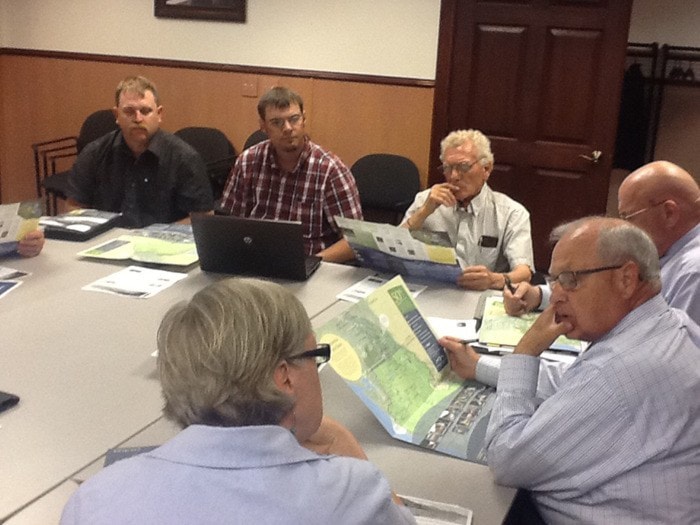I just returned from a 2,100 kilometre epic journey through Washington and Oregon representing the Local Governments Committee that is engaged in the Columbia River Treaty process. There was a conference in Vancouver, WA and we took the opportunity to learn more about our US neighbours and to educate them about us.
The Columbia River ties us together across the boundary and we learned that each community along the way is passionately engaged in its relationship with the river.
The United States has been hosting “listening sessions” in communities across the Basin with the intention of educating people about the Treaty and sharing the possible future scenarios or “iterations” that the Bonneville Power Corporation has developed.
Our first stop was a listening session in Pasco, WA. About 30 people were in attendance. The US has been building dams on the Columbia for many years prior to the Treaty dams. There are about 2,500 of them along the river, some privately owned while others are under state and federal jurisdiction.
The Treaty stipulates that Canada and the US share power generation profits from the four Treaty dams 50/50. This means that the US returns Canada’s share in the form of hydropower and BC Hydro can sell it to whoever they wish. Power prices have dropped in recent years because other energy sources have been developed and natural gas is a cheaper alternative. In the past, the Canadian entitlement was worth $250 to $350 million/year. More recently, it is about $100 million/year.
The Canadian entitlement is one of the Treaty stipulations that the US wants to renegotiate. It is their belief that they are paying too much and they estimate the entitlement at around $20 million/year. Canadian entities disagree with that assessment. In terms of flood control, it is estimated that the US would have incurred over $3 billion in damages in the last major flood had it not been for coordinated control efforts. This point promises to be a major issue in discussions.
From Pasco, we hit the road to Boardman, OR. The countryside is flat, very dry and the day was hot, in the high 30’s. Annual rainfall in some parts is seven inches/year. We saw a lot of lush, irrigated fields immediately adjacent to sagebrush with a variety of crops being grown including food crops, alfalfa, and a tree farm for lumber and paper production. Greenwood is a 30,000 acre tree farm that exports much of its product to the Asian market. Irrigation techniques vary, but what we noticed is that water is generously used. This is made possible through subsidies in power production making it cheap to pump from the river.
The Boardman group included county commissioners, water project coordinators and port authority managers.
Farming is big business here and access to water is critical. The aquifers that were exploited in the 1950’s are drying up and Boardman is looking for federal permission to undertake a water project that will take water from the Columbia to replenish them. There are strict regulations around water being pumped out and the project may be denied.
The same scenario around water becoming more scarce was heard in our meeting the next day with people from the Moses Lake, WA area. People are noticing that the water table is dropping and that there are more frequent droughts. In both cases, requests were made to Canada for possible increases to water flow.
This was our opportunity to educate people about what the impact of the dams has been and continues to be to our area. Canadian reservoirs provide 51 per cent of the storage capacity for the four treaty dams, a total of 15.5 million acre feet and Canada manages close to 9 million acre feet for flood control. That’s a lot folks.
The Canadian reservoirs are industrial reservoirs. They are operated to produce the highest benefit for power production and flood control. This means the water level can drop up to 30 meters at a time resulting in mud flats, dust storms and erosion. This means challenges to wildlife, recreation and tourism and a host of other issues.
Many of our US neighbours were not aware of this and wanted to learn more. We extended an invitation to Canada.
The next leg of the journey took us through greener landscape to Portland, OR and a meeting with Michele DeHart, a biologist for the Fish Passage Centre. Michelle has been a passionate advocate for the return of salmon to the Columbia for over 25 years and is currently working with the Okanogan Nation to return the sockeye on the Canadian side. She has strong views based on scientific research about how the management of the river needs to change for fish and the environment. Status quo is not part of her language.
The conference itself was a further education in what is happening to the Columbia. One of the most important discussion points was the need to look at the system as a whole, without boundaries to make the best decisions for the future.
People on both sides of the border realize that things have changed since the Treaty was signed in 1964 and they want other issues included as we move forward. Part of that change is developing a deeper understanding of where people live and what they think.
If you haven’t had a chance, I encourage you to learn more at blog.gov.bc.ca/columbiarivertreaty
